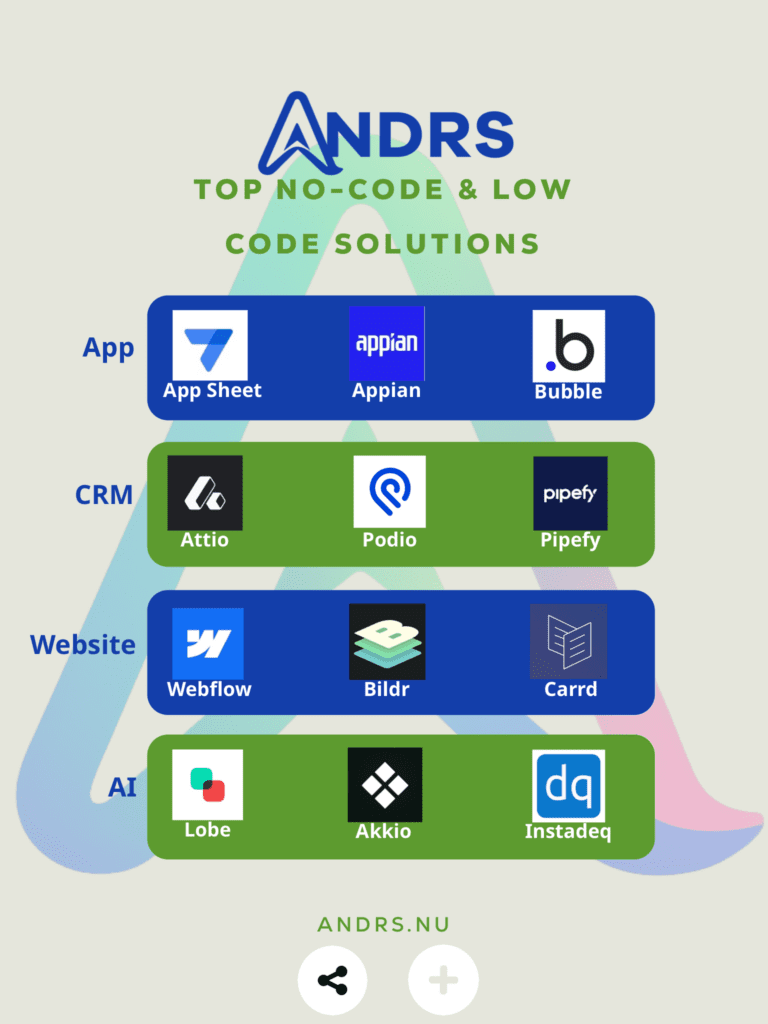Introduction to no-code and low-code (NCLC)
In software development, low-code and no-code platforms have emerged as game-changers. These tools empower you as a SaaS founder to create applications faster, more cost-effectively, and with greater flexibility. Let’s dive into how this revolution is reshaping the SaaS industry.
What Are They?
Low-Code Platforms:
Low-code platforms provide a visual development environment where developers can create applications with minimal hand-coding.
How They Work: These platforms offer pre-built components, drag-and-drop interfaces, and reusable modules. Developers can assemble these elements to build functional applications.
Target Audience: Low-code platforms primarily cater to professional developers who want to streamline development processes and reduce manual coding efforts.
Use Cases: Rapid prototyping: Quickly create proof-of-concept applications. Internal tools: Develop custom solutions for business processes. Integrations: Seamlessly connect different systems.
Example Tools: OutSystems, Mendix, Appian.
No-Code Platforms:
No-code platforms take simplicity to the next level by allowing non-technical users (often referred to as “citizen developers”) to create applications without any coding knowledge.
How They Work: These platforms offer intuitive interfaces, templates, and pre-configured logic. Users can build apps by configuring settings rather than writing code.
Target Audience: No-code platforms empower business analysts, marketers, entrepreneurs, and other non-developers to create custom solutions.
Use Cases: Internal tools: Create department-specific apps. Workflow automation: Streamline repetitive tasks. Online applications: User interfaces with a robust backend, Personal projects: Build hobby apps or personal websites.
Example Tools: Bubble, Adalo, Glide.
Why Are They Important?
Democratization of Development & Cost-Efficiency
LCNC platforms break down barriers to entry. They allow a broader range of people to participate in app creation, fostering innovation. As a SaaS founder you can now turn your ideas into reality without waiting for a dedicated development team.
Traditional development requires hiring skilled developers, which can be expensive. NCLC platforms reduce reliance on specialized talent, saving costs for SaaS startups. Now intuitive interfaces and pre-built components empower non-technical founders. As a founder you now can customize workflows, automate processes, and create tailored solutions without writing a single line of code.
“The high cost of tech talent and a growing hybrid or borderless workforce will contribute to low-code technology adoption,”
Jason Wong, Distinguished VP Analyst, at Gartner
Challenges and Considerations
Scalability and Customization
While NCLC platforms accelerate initial development, scaling can be challenging. As a SaaS founder you must strike a balance between customization and platform constraints.
Initial Acceleration vs. Long-Term Scalability:
Initial Development: LCNC platforms excel at speeding up the initial development phase. SaaS founders can quickly create prototypes and MVPs.
Scaling Challenges: However, as a user base grows and feature requirements evolve, scalability becomes a concern. These platforms might not handle large-scale applications or complex workflows efficiently.
Balancing Act: As a SaaS founder you must strike a delicate balance between leveraging the platform’s rapid development capabilities and ensuring that the solution can scale seamlessly. Customization often requires more traditional coding to optimize performance.
Customization Constraints:
Platform Limitations: No-code platforms, in particular, have predefined templates and components. While this simplifies development, it can limit the extent of customization.
Trade-Offs: You need to weigh the benefits of quick development against the limitations imposed by the platform. Sometimes, a custom-coded solution is necessary for specific features or integrations.
Security and Compliance
SaaS applications built on these platforms must address security risks and comply with regulations. You should always prioritize data integrity and user privacy. You can do that by conducting thorough security assessments, implement best practices, and stay informed about platform updates.
AI and the impact on no-code low-code market
Analysts predict remarkable growth for low-code and no-code platforms not in the least as result of the use of generative AI.
Natural Language Processing (NLP)
NLP capabilities enable you to interact with low-code no-code platforms using natural language commands. AI algorithms understand user queries and commands, translating them into actions within the platform. This simplifies the development process, allowing you to build applications using plain language instructions without needing to learn complex programming languages.
Machine Learning Integration
Many LCNC platforms integrate machine learning capabilities, allowing users to incorporate predictive analytics and decision-making functionalities into their applications without extensive coding. AI algorithms within these platforms can analyze data, identify patterns, and make intelligent predictions, empowering users to create advanced applications with predictive capabilities.
Code Optimization
AI algorithms optimize the generated code within LCNC platforms, improving performance, scalability, and efficiency. These algorithms analyze code patterns, identify bottlenecks, and suggest optimizations to enhance application quality and performance, even without deep coding knowledge.
Intelligent Assistance
AI-powered intelligent assistants provide guidance and recommendations throughout the application development process. These assistants offer suggestions for design choices, data modeling techniques, and feature implementations based on best practices and historical data, helping users build high-quality applications more efficiently.
Conclusion
Low-code and no-code platforms are reshaping the SaaS world. As a SaaS founders you should embrace these tools, experiment fearlessly, and ride the wave of innovation. Remember: The future belongs to those who can create without boundaries.

Caroline Vrauwdeunt
CEO/Founder of ANDRS Projects: An innovator who believes innovation can only arise from collaboration. Her life’s motto is “Collaborate or Die”.
We know what is takes to bring your platform to success. Having encountered all the pitfalls of raising SaaS brands we have got the experience that will benefit you. Don’t believe the flashy high prized agencies when they say they know it all. Because we know they don’t know, we have been there.
So don’t hesitate to get in touch and send us a message.
Sources:
This post was created with some help of AI (ChatGPT 4) and the following references
1. Low-Code vs. No-Code: What’s the Difference? 2. Top 10 Low-Code Platforms in SaaS 3. Gartner Trendreport 2022 4. Gartner Trendreport 2024
